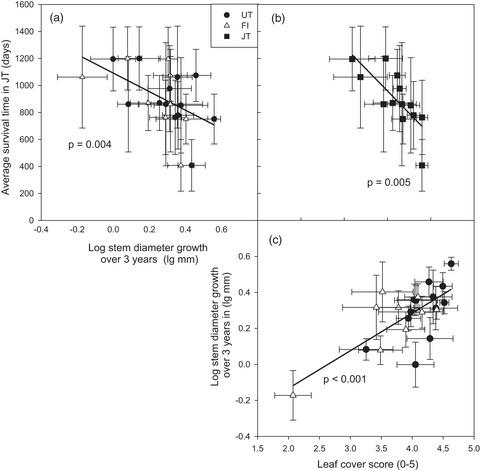Our official English website, www.x-mol.net, welcomes your
feedback! (Note: you will need to create a separate account there.)
Local climate adaptations in two ubiquitous Mojave Desert shrub species, Ambrosia dumosa and Larrea tridentata
Journal of Ecology ( IF 5.3 ) Pub Date : 2021-07-15 , DOI: 10.1111/1365-2745.13747 N. A. Custer 1 , S. Schwinning 1 , L.A. DeFalco 2 , T.C. Esque 2
中文翻译:

两种普遍存在的莫哈韦沙漠灌木物种 Ambrosia dumosa 和 Larrea tridentata 的局部气候适应
更新日期:2021-07-15
Journal of Ecology ( IF 5.3 ) Pub Date : 2021-07-15 , DOI: 10.1111/1365-2745.13747 N. A. Custer 1 , S. Schwinning 1 , L.A. DeFalco 2 , T.C. Esque 2
Affiliation

|
- Widely distributed species are often locally adapted to climate gradients across their ranges. But little is known about the patterns of intraspecific adaptation in desert shrubs.
- We examined the questions of local adaptation in multiple populations of two common shrub species of the winter-wet Mojave Desert in North America in a multiple common garden experiment. Plants were raised in the greenhouse and transplanted at the age of 1 year. Ambrosia dumosa is a drought-deciduous low shrub and Larrea tridentata is an exceptionally long-lived evergreen. Over 4 years, we monitored growth, survivorship, leaf and reproductive cover and once measured leaf N content, δ13C and SLA. We hypothesized that populations of both species would be differentiated along a growth–survivorship trade-off according to homesite aridity.
- Both species exhibited previously undocumented population differences along gradients of winter precipitation and temperature. In general, populations from more winter-mesic regions had faster growth in more mesic gardens and lower survivorship in the most arid garden. Homesites with more variable summer precipitation had greater growth for A. dumosa populations, but lower growth for L. tridentata. Among L. tridentata populations, leaf cover correlated positively with growth and negatively with survival time. For A. dumosa populations, growth and survival could not be attributed to specific traits across gardens. However, larger transplants had generally lower growth rates and higher survival rates across gardens, except in the driest garden, where the population averages of intrinsic water use efficiency (iWUE) and stem growth rate were positively correlated.
- Synthesis. Two dominant species of the Mojave Desert adapted locally to variation in winter and summer precipitation and temperature. They did so in different ways, suggesting that L. tridentata mitigated the risk of hydraulic failure, while A. dumosa optimized carbon assimilation for growth.
中文翻译:

两种普遍存在的莫哈韦沙漠灌木物种 Ambrosia dumosa 和 Larrea tridentata 的局部气候适应
- 广泛分布的物种通常在当地适应其范围内的气候梯度。但对于沙漠灌木的种内适应模式知之甚少。
- 我们在多个常见的花园实验中研究了北美冬季潮湿莫哈韦沙漠的两种常见灌木物种的多个种群的局部适应问题。植物在温室中饲养并在 1 岁时移植。Ambrosia dumosa是一种干旱的落叶低矮灌木,Larrea tridentata是一种非常长寿的常绿植物。4 年多来,我们监测了生长、存活率、叶片和生殖覆盖,并曾经测量过叶片 N 含量、δ 13 C 和 SLA。我们假设这两个物种的种群将根据居住地的干旱程度在生长 - 生存权衡中进行区分。
- 这两个物种在冬季降水和温度的梯度上都表现出以前未记录的种群差异。一般来说,来自更多冬季中空地区的种群在更多的中空花园中增长更快,而在最干旱的花园中存活率较低。夏季降水变化较大的住宅区的A. dumosa种群增长较大,但L. tridentata的增长较低。在L. tridentata种群中,叶盖度与生长呈正相关,与存活时间呈负相关。对于A. dumosa人口、生长和生存不能归因于整个花园的特定特征。然而,较大的移植物在整个花园中通常具有较低的生长率和较高的存活率,除了在最干燥的花园中,内在用水效率 (iWUE) 和茎生长率的种群平均值呈正相关。
- 合成。莫哈韦沙漠的两个优势物种在当地适应了冬季和夏季降水和温度的变化。他们以不同的方式这样做,表明L. tridentata减轻了水力失效的风险,而A. dumosa优化了碳同化以促进生长。











































 京公网安备 11010802027423号
京公网安备 11010802027423号